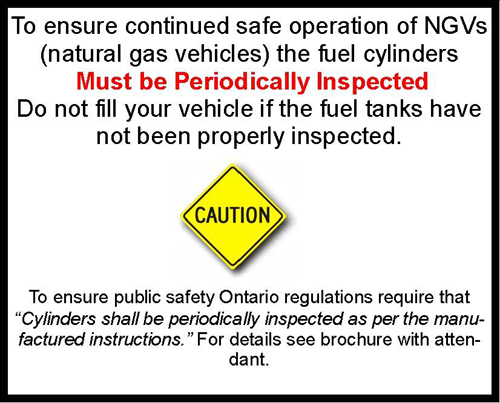|
|
Case Study
Natural Gas Fuel Cylinder Failure

Surface pitting and corrosion of steel cylinders: Corrosion and pitting can reduce surface thickness leading to loss of integrity. [3] |
The following description of a CNG cylinder rupture is quoted directly from the fact sheet prepared by Charonic Canada Inc. in conjunction with Powertech Labs Inc. and the Ontario Technical Standards and Safety Authority. [1] The case demonstrates the importance of regular cylinder inspections.
At approximately 21:00 hours on Wednesday, September 3rd, 2003 a natural gas cylinder installed on a vehicle ruptured during fuelling at a Shell Canada station located at 1201 Markham Road, Scarborough.
The cylinder was one of three that were installed on a 1994 Dodge Ram B250 Van when it was converted to bi-fuel gasoline/natural gas operation in April 1994. The three cylinders were 70-litre Faber, 15-year life, all-steel cylinders manufactured in accordance with CSA B51 Appendix G, with Canadian Registration Number K4928.5. This registration requires a visual inspection at least every three years.
The two cylinders mounted inside the vehicle were undamaged and had retained the original paint coat applied before installation. The failed cylinder had been mounted under the vehicle parallel to the exhaust system and had suffered severe localized corrosion. At the time of failure the vehicle was fitted with what was said to be a “fairly new” replacement exhaust system.
Prior to the incident, the driver of the van had reported on the mornings of September 2nd and 3rd that there was a smell of natural gas in the van.
The driver reported that he believed the cylinders were empty when the vehicle arrived at the station and that only $10 worth of fuel had been dispensed into the vehicle at the time the cylinder failed. He stated that usually it took $25 to fill the vehicle from empty. A full fill on the day of the incident would have resulted in a cylinder pressure of approximately 3400 psi, so that it is estimated that the failure occurred at less than 1700 psi.
Following the incident, the vehicle was inspected and the failed cylinder was sent to Powertech Labs Inc. for evaluation. Powertech conducted a failure analysis and reported that:
- The materials properties of the ruptured cylinder were consistent with the specifications and test results provided by the cylinder manufacturer.
- An area of significant corrosion measuring approximately 10 inches in length and 4 inches in width was visible on the exterior surface of the cylinder.
- Large-scale pits at depths of up to 66% of the cylinder wall thickness were observed in the heavily corroded area.
- The accelerated external corrosion is consistent with what would be expected from exposure to heat and exhaust emissions associated with the cylinder’s proximity to the vehicle’s muffler.
- The cylinder failure mechanism is consistent with what would be expected from the reduced wall thickness associated with the observed external corrosion.
Powertech did not observe any retest or inspection markings on the failed cylinder and no documented or anecdotal evidence has been found indicating that it had been inspected by a qualified person.
Conclusions:
- There is no evidence that this cylinder type or model is unsafe if properly installed and maintained.
- The cylinder failed through weakening caused by external corrosion.
- The corrosion was probably caused by exposure to hot exhaust gases from a leaking exhaust system.
- The corrosion would have been readily apparent on visual inspection.
- The cylinder would have been condemned if inspected by a qualified person.
Investigators noted that the first owner of the vehicle had been instructed as to its use and the need for inspection, and that the owner at the time of the rupture was the third owner, a warning sign was proposed for refueling stations.

Fueling station warning sign recommended after this incident.[1] |
References
|
|
|